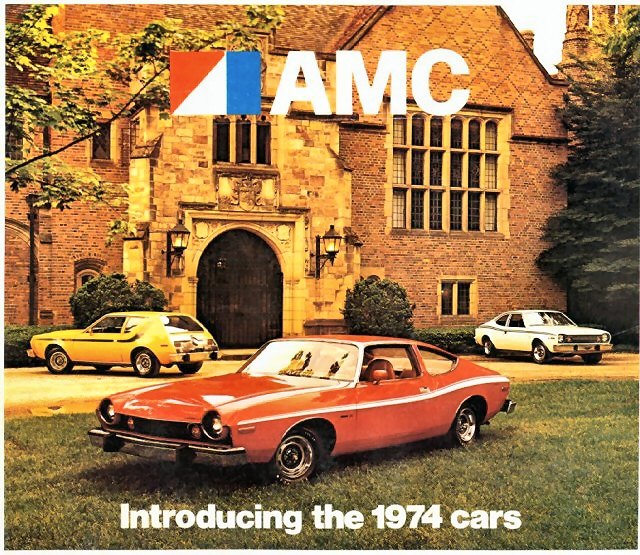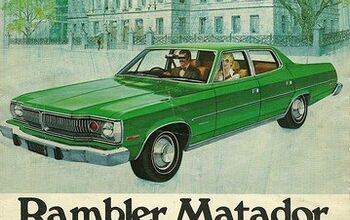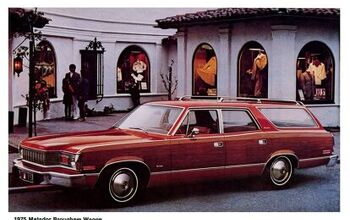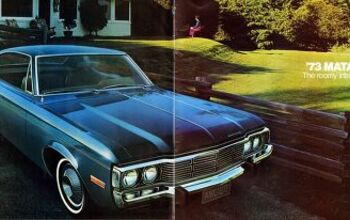Rare Rides Icons: The AMC Matador, Medium, Large, and Personal (Part II)

AMC introduced its new Matador lineup into the very competitive intermediate (midsize) car market in 1971. It was a time when the company was making advances in build quality, streamlining, and an industry-leading all-encompassing warranty. And though the Rebel by any other name was selling decently, it wasn’t grabbing market share as AMC expected. Especially lackluster were sales of the Matador Coupe, a body style that was the top seller amongst its domestic competitors. As 1974 approached, AMC prepared to make some big changes to Matador, and introduce an all-new two-door.
The second-generation Matadors aside from the Coupe were not new cars, but a heavy refresh of the 1971 to 1973 version. The two standard body styles were offered again: A relatively conservative four-door sedan and wagon. The most notable change was to the Matador’s front end, which grew a squared-off coffin nose. The new snout added an overhang onto the Matador, for that true Coming With Length look. The rear clip of the sedan was reworked as well, while rear-end changes to the wagon were limited to the tail lamp design and a revised bumper. The four doors used the same 118-inch wheelbase as they had in 1973 but were now longer overall.
The additional styling moved the Matadors to be more competitive with other intermediates, as cars increased in size in the early Seventies. Part of the larger size was down to NHTSA requirements, which said bumpers had to have uniform heights, absorb impacts from multiple angles, and withstand five mile-per-hour impacts undamaged. Like every other manufacturer, AMC provided giant chrome bumpers in 1974 and included shock-absorbing mounts. AMC went for an integrated look and used body-colored plastic fillers between bumper and grille on the sedan and wagon. Length on the sedan increased 10 inches, to 216 overall. The wagon gained 10 inches as well, for a total of 215. Though they had generous proportions, the Matadors were still short of full-size dimensions. AMC offered the Ambassador in 1974, but it was a scant 217.8 inches long, compared to the luxurious 222.7 inches of a Chevrolet Caprice. More on size issues in a moment.
All versions of the second-gen Matador got new interiors to keep with the times. Dashboards were now fully padded and sculpted with an eye to crash safety. Gauges were in three different pods in front of the driver. The radio was a new design too, and the Rebel-sourced horn pad from 1970 was replaced by a new rectangular design that was soft to the touch. But interiors and four-door Matadors were not AMC’s focus in 1974; they’d spent all the big bucks on the new Coupe.
An all-new car for 1974, the Matador Coupe was a two-door pillared hardtop that was styled in an entirely different direction to the four-door models, and indeed the Matador Coupe sold through 1973. AMC knew intermediate buyers gave much weight to coupe styling and went all-out.
The Coupe was penned by AMC’s lead designer Dick Teague, who also consulted with Matador’s NASCAR driver Mark Donohue. The new Coupe shared no body panels with its four-door siblings and was intended as a daring showcase of AMC’s styling. Sweeping lines and a fastback-style roofline made the Coupe much more aggressive than before, with headlamps that grew from tunnels along the hood.
Matador Coupe used a flat front and a full-width grille and thankfully forewent the familial coffin nose treatment. A sweeping chrome trim strip on luxury models highlighted the curves of the Coupe, while sports trims used a full perimeter painted racing stripe instead. Doors had frameless glass, always a stylish touch. The Coupe rode on a four-inch shorter wheelbase than four-door siblings, at 114 inches. Overall length was notably shorter on the two-door, at 209.3 inches. It was lower to the ground too, with an overall height of 51.8 inches. That was two inches lower than the sedan, and nearly five compared to the wagon.
Matador Coupe was meant to be dressed to customer preference, as aging and sophisticated buyers abandoned muscle cars for more practical (and affordable) personal luxury coupes. Base models used inline-six engines, while the sporty Matador X version had a standard V8. AMC had good timing with the Coupe, as in 1974 its Matador was the only all-new model in the intermediate coupe market. Top competition came in the form of the Ford Torino, Plymouth Satellite Sebring, and the Chevy Chevelle. The Matador stood out amongst its peers with bold, unique styling that was broadly praised by consumers. Said consumers put their money where their mouth was, as Coupe sales shot up to 62,629 in the new Matador’s first year, up from just 7,067 the year prior. The Coupe outsold the Matador wagon and sedan by almost 25,000 units in its first year.
Though there were many changes to the Matador inside and out for 1974, engine choice was not among them. For 1974, two inline-six engines remained on offer, of 232 (3.8L) and 258 (4.2L) cubic inches. V8 options included 304 (5.0L), 360 (5.9L), and 401 (6.6L) cubic inch displacements. Again a three-speed manual was offered, only on lower-end models. Most buyers of the Matador chose the Chrysler-sourced three-speed TorqueFlite (or TorqueCommand in AMC speak) automatic. Emissions regulations had their way with the Matador’s engine lineup though, and 1974 was the last time the 232 inline-six and 401 V8 were offered to the public. The 401 was technically still available in 1975, but only to fleet and police buyers. The three-speed manual was offered through the 1976 model year; its take rate was low enough for AMC to kill the option.
Following its introduction, changes to the Matador line amounted mostly to trim adjustments and the aforementioned elimination of engine options, as in 1975 AMC spent most of their development dollars on the new and quirky compact Pacer.
Looks were updated on sedan and wagon via a full-width grille that wrapped around the coffin nose, and square parking lamps that replaced circular ones. Matador Coupe retained the circular parking lamps. The body of the Matador sedan and wagon remained in their 1975 guise through the end of the model’s run, with no further changes.
In 1975 the Matador was forced to do double duty as AMC’s largest car offering, as the slow-selling Ambassador was discontinued after 1974. Ambassador had been on sale since 1969 with only minor trim adjustments, as AMC stretched it from its original 206.5-inch length to 217.8 inches in its final year. AMC attempted to keep with large car buyer demands and government regulation while spending as little as possible on Ambassador, but consumers by and large looked elsewhere for their full-size needs. Consumer tastes were also trending downward size-wise by 1974, and AMC threw in the full-size towel.
Things were still going okay for the Matador lineup in 1975, but it all went downhill rather quickly. Changing consumer tastes, the arrival of super-efficient Japanese cars, and the US energy crisis would all play their part in killing off the last midsize car AMC would ever make. More on that next time.
[Images: AMC]

Interested in lots of cars and their various historical contexts. Started writing articles for TTAC in late 2016, when my first posts were QOTDs. From there I started a few new series like Rare Rides, Buy/Drive/Burn, Abandoned History, and most recently Rare Rides Icons. Operating from a home base in Cincinnati, Ohio, a relative auto journalist dead zone. Many of my articles are prompted by something I'll see on social media that sparks my interest and causes me to research. Finding articles and information from the early days of the internet and beyond that covers the little details lost to time: trim packages, color and wheel choices, interior fabrics. Beyond those, I'm fascinated by automotive industry experiments, both failures and successes. Lately I've taken an interest in AI, and generating "what if" type images for car models long dead. Reincarnating a modern Toyota Paseo, Lincoln Mark IX, or Isuzu Trooper through a text prompt is fun. Fun to post them on Twitter too, and watch people overreact. To that end, the social media I use most is Twitter, @CoreyLewis86. I also contribute pieces for Forbes Wheels and Forbes Home.
More by Corey Lewis
Latest Car Reviews
Read moreLatest Product Reviews
Read moreRecent Comments
- CanadaCraig As an aside... you are so incredibly vulnerable as you're sitting there WAITING for you EV to charge. It freaks me out.
- Wjtinfwb My local Ford dealer would be better served if the entire facility was AI. At least AI won't be openly hostile and confrontational to your basic requests when making or servicing you 50k plus investment and maybe would return a phone call or two.
- Ras815 Tesla is going to make for one of those fantastic corporate case studies someday. They had it all, and all it took was an increasingly erratic CEO empowered to make a few terrible, unchallenged ideas to wreck it.
- Dave Holzman Golden2husky remember you from well over decade ago in these comments. If I wanted to have a screen name that reflected my canine companionship, I'd be BorderCollie as of about five years go. Life is definitely better with dogs.
- Dave Holzman You're right about that!










































Comments
Join the conversation
Rumor had it that Roger Penske had some say about the two door body being more suited to Stock Car Racing. Penske had some sucess in the USAC stock division with the 2-door. I liked the 2-door styling but the 4-door and later models were some of the ugliest American sedans ever made.
That coupe used to make me laugh, it was so hideous. A neighbor had a white Matador coupe for a couple of years. It was a base car, so the giantic wheel openings looked even more "off the deep end" then they did with some halfway decent sized tires. The Matador joined in with the rest of the "car belonging to nerds and other weirdos" vibe the Pacer, Gremlin, and Hornet had at the end.